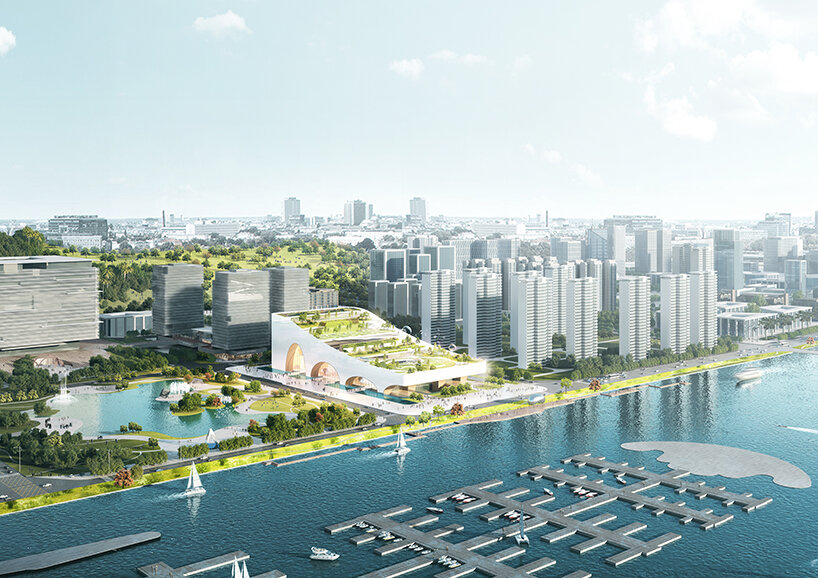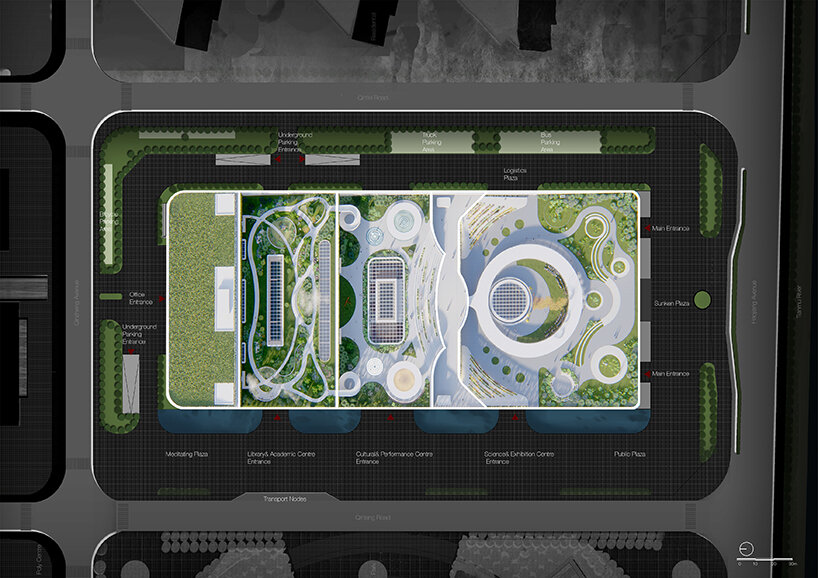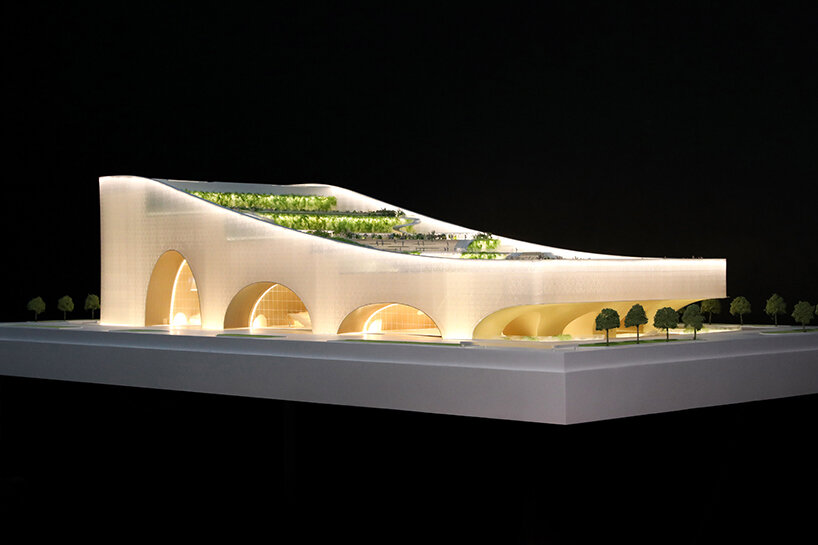Hengqin Culture & Art Complex by yunchao xu/atelier apeiron
Yunchao Xu/Atelier Apeiron unveils its work in progress on the 142,560 sqm Hengqin Culture & Art Complex, a future community focal point in one of China’s fastest-growing cities destined to serve the entire Guangdong-Hong Kong-Macao Greater Bay Area. Six years into the new complex’s planning, design, and construction, the studio’s work is approaching its final stages.
In the more than a decade that has followed Chinese government approval of the massive and ambitious urban development of Hengqin Island, sitting at the crossroads of the Pearl River and South China, billions of dollars in investments have poured into the project referred to as the ‘Hengqin New Area.’ Dozens of major projects are being developed, all within walking distance of Macau and only 34 nautical miles from Hong Kong. In the center of it all, the 106-square-kilometer island is a new addition to the populated region, with clusters of developments targeting the high-profile sectors of culture, creativity, and knowledge.

all images © Yunchao Xu | full header video © Atelier Apeiron
a new community hub in china’s third-fastest growing city
In 2018, Atelier Apeiron won a competition launched by the Chinese government to field proposals for building the Hengqin Culture & Art Complex as part of a vibrant new community in the country’s third-fastest growing urban center after Hong Kong and Macao. The firm’s winning proposal centered around embracing a new and innovative approach to the massive nine-block development. ‘The complex will house nine departments, but the requirements for each were independent and filled with contradictions,’ comments lead architect Yunchao Xu. ‘We approached it from the perspective of integrating nine independent buildings into a single complex, and we convinced the client to give each department relative independence to proceed with a comprehensive strategy that resolves conflicts and stimulates public energy.’

the project is completing in the ‘Hengqin New Area’
adapting to the region’s climate, land, and density
A typhoon-prone area in summer, the site came with its challenges, pushing the architect to lay out special considerations, like choosing suitable wind-resistant materials, and the choice landed on a light and flexible suspended glass curtain wall. Another challenge was introducing natural light into such large volumes. Furthermore, being on an island with a sub-tropic climate, the foundations of the expansive complex presented a third problem, with a natural layer of silt that can cause stability issues. In response, the firm designed a basement as a sealed support space with anchor points to ensure maximum strength throughout the structure.
The site of the Hengqin Culture & Art Complex is wedged between existing residential towers and an open city park. Atelier Apeiron devised a strategy for an energetic complex capable of accommodating a multifunctional future. As part of that strategy, the practice sought large-scale architectural porosity adapted to the high-density urban context of the site’s surroundings.

evoking natural formations through an undulating green rooftop
an inverted catenary with dramatic archways
On the lower level of the complex, Apeiron is applying a geometric concept of inverted catenary to create three sweeping arches of differing shapes, combining Chinese and Western elements. Each arch is a gateway to a different hall, unique in character and program. To draw natural light into the inherently dark spaces, the architect carved a skylight above the arches to connect with the rooftop gardens and even incorporated two diffuse reflectors that direct soft sunlight into the rooms.
Composed of wood and bamboo panels, the arched provide a window of transparency between the facility and its surrounding urban life. By day, visitors will enjoy unobstructed external views of the adjacent park, while nights will be illuminated by the soft lighting emitted by the transparent arched halls, forming a stage background for various public events to be held in the park.

three archways of different sizes
‘Arches have been embraced as a critical form of architecture since the beginning of time and are prevalent in both Eastern and Western culture,’ shares Xu. ‘To create strong structures with available materials, arches have been used to convert shear force in a horizontal direction into vertical force, ensuring that all structure points carry a shared load.’ Above the archways, modular space units have been integrated into the design to ensure maximum flexibility options for various future programs. Additionally, small spaces have been integrated into the arch joints to house equipment and building services.

entrance to the Knowledge Hall
three distinct halls and an array of communal programs
With the massive complex designed to house nine distinct functions — a library, an archives center, a concert hall, a cultural center, an art gallery, a science museum, a women’s and children’s activity center, an elderly activity center, and a youth activity center — Yunchao Xu/Atelier Apeiron wanted to create a truly communal sense of being. Designed as three urban living rooms, each arch leads into a unique space comprising a Knowledge Hall, a Performance Hall, and an Exhibition Hall.
For the Knowledge Hall, the firm drew inspiration from the Oodi library in Finland, where its function has progressed beyond being merely a reading space. Taking the concept of traditional libraries to new heights, the Knowledge Hall will feature a vertical village of crystal book blocks and will become a focal point of urban public activity. Meanwhile, the adjacent Performance Hall serves as a cultural performing arts center, with a large open stage and black box theater designed for dance, music, theater, and opera productions.
Finally, the Exhibition Hall unfolds as a porous space, where strategically placed ‘cheese holes’ invite scatters of mysterious natural light into a host venue for exhibitions of art and science. Together, the three halls offer visitors a range of parallel world experiences, all within the confines of a single complex. ‘The modular design of the complex ensures that each of the nine pavilions has its own distinct spaces, and the three large halls follow that same rationale,’ continues Yunchao Xu.

evoking natural formations via a stacked, four-level layout
With its inspirations often derived from nature, Yunchao Xu/Atelier Apeiron has incorporated natural prototypes into the Hengqin Culture & Art Complex, including terraces, caves, and cliffs. A stacked, four-story arrangement of rooftop platforms provides serene public views, with living green balconies overlapping the urban structure like park settings for hosting community-based events. In designing the gardens, Xu conducted multiple studies to ensure optimal sightlines from each platform.
The base platform includes a semicircular stage and a circular auditorium, where the Macau Wedding Company will organize large-scale weddings, birthday parties, corporate team-building activities, and much more. At 24 meters, a platform designed as a children’s theme park features sand pits, expansive play facilities, restaurants, museums, and family cafes. At 30 meters, another platform provides a shared garden, with the addition of staff canteens and cafeterias for employees to rest and enjoy their environment. Finally, rising 36 meters, a rain garden platform serves as an environmental zone, integrating ecology, a low carbon footprint, and green technologies as an ecological laboratory. Finally, a spiral staircase invites visitors to ascend to a bamboo garden, where serenity and quiet moments can be experienced while enjoying a cup of tea adjacent to the Sky Bookstore.

dramatic gestures unfold across the culture & art complex
Extending from a hill to the north to a river to the south, the catenary curve of the Hengqin Culture & Art Complex has created a new skyline landmark, with construction scheduled for completion in 2024. In close collaboration with material scientists, botanists, climatologists, acoustic experts, and many other experts, ‘our vision is for the Hengqin Culture & Art Complex to be a vibrant, three-dimensional vertical city that will host millions of tourists each year, as well as a growing community of residents, while seamlessly connecting with its surrounding environment,’ concludes the practice.

strategically placed ‘cheese holes’ invite scatters of mysterious natural light


entrance to the Performance Hall

entrance to the Exhibition Hall

the project is expected to complete in 2024











project info:
name: Hengqin Culture & Art Complex
location: Hengqin island, China (Guangdong-Macau In-Depth Cooperation Zone)
client: Zhuhai Gree Construction Investment Co,. Ltd.
architecture: Yunchao Xu/Atelier Apeiron
lead architect: Yunchao Xu
team: Jiachuan Qi, Hongrui Liu, Kan Gao, Guohong Li, Zhendong Shi, Jianxuan Chen,
Shengjie Zhang, Kun Qian, Kai Liao, Zheng Xu, Zhen Shen
technical CAD design: SZAD
contractors: Zhuhai Gree Construction Investment Co,. Ltd.
construction: Zhuhai Jianan Group Co,. Ltd.
engineering: SZAD
interior design collaborator: Ruan Bin Design
landscape architecture: GVL Green View Landscape Group
lighting consultant: GD Lightning
acoustics consultants: Zhongfutai Architecture Construction Co., Ltd.
heating, ventilation, and air conditioning: SZAD
start year: 2018
completion year: 2024
total area: 142,560 sqm
architecture in china (1801)
PRODUCT LIBRARY
a diverse digital database that acts as a valuable guide in gaining insight and information about a product directly from the manufacturer, and serves as a rich reference point in developing a project or scheme.








